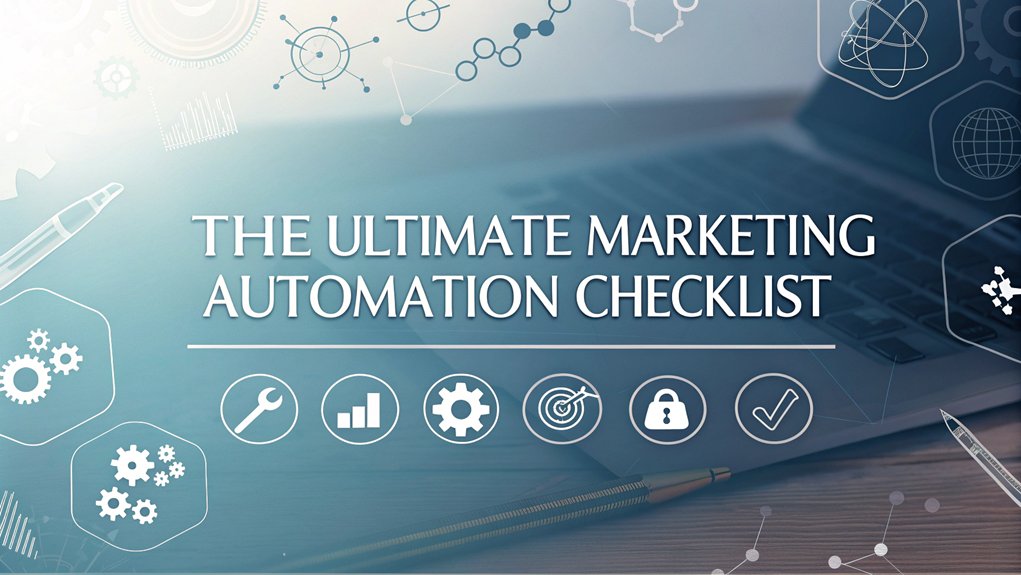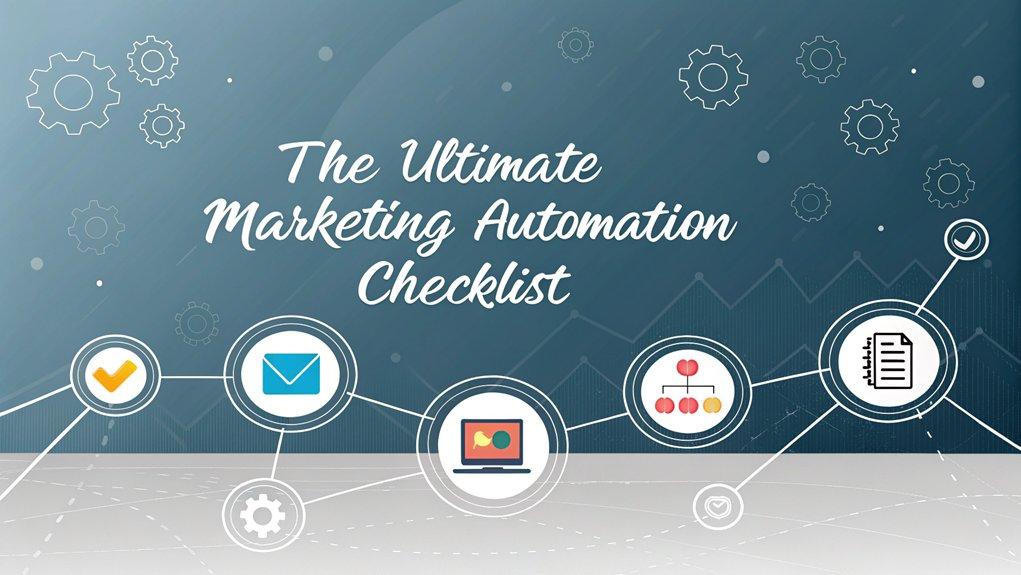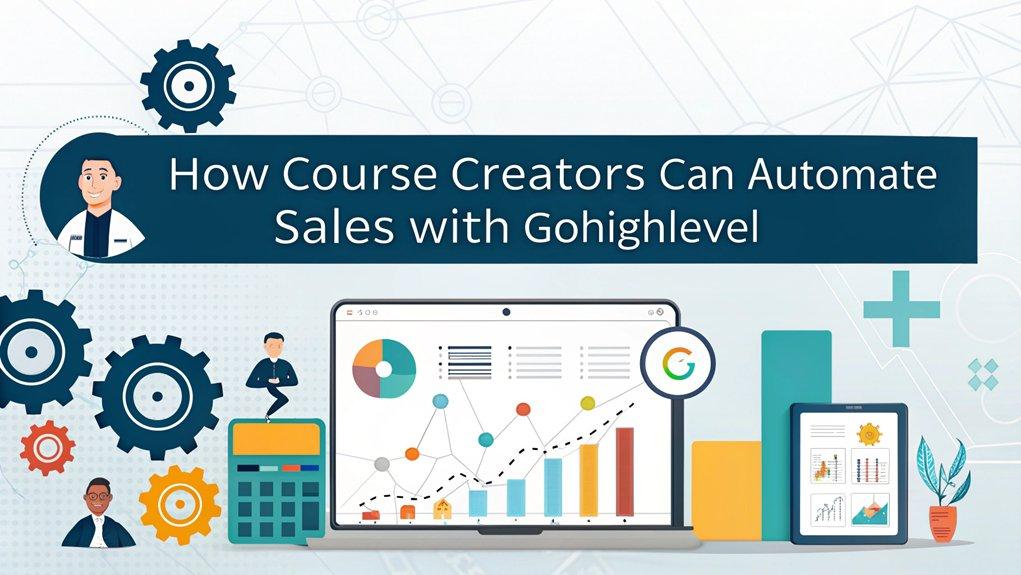To create your ultimate marketing automation checklist, start by setting SMART goals aligned with business objectives. Continuously review and enhance marketing methods, and choose automation software that’s compatible with your systems. Segment your audience effectively using behavior insights. Develop automation workflows and personalize content to improve engagement. Monitor and test strategies through A/B testing and performance metrics. Document processes meticulously. You’ll discover more insights that can transform your marketing strategy significantly by continuing further.
Key Facts Summarized
- Establish SMART goals to align marketing automation with business objectives and track success through key metrics like conversion rates.
- Choose scalable, user-friendly automation software that integrates seamlessly with existing systems like CRM and CMS.
- Segment your audience using value-based techniques and tailor messaging to resonate with specific groups.
- Map out customer journey stages to identify automation opportunities and enhance engagement through personalized workflows.
- Regularly test, monitor, and adjust strategies using A/B testing and performance metrics to optimize marketing efforts.
Setting Clear and Measurable Goals
Why is setting clear and measurable goals crucial in marketing automation? Establishing SMART goals is the backbone of a good marketing automation strategy.
By defining specific, measurable, achievable, relevant, and time-bound objectives, you align your efforts with the broader business goals. This clarity enhances lead generation and customer engagement, ensuring each step of the customer journey is strategically mapped.
Industry research shows that organizations with well-defined goals see a 20% boost in lead generation and retention. Setting key metrics like lead-to-customer conversion rates and ROI enables you to track success effectively.
Companies with these metrics are 70% more likely to implement automation tools successfully. Regularly revisiting goals ensures adaptability and continuous improvement in your marketing automation strategy, while also enhancing customer engagement through informed decision-making based on market research.
Reviewing and Optimizing Current Marketing Methods
Even though your marketing methods might be producing results, it’s essential to regularly review and optimize these strategies to unlock their full potential.
Scrutinize current marketing processes to identify inefficiencies using marketing automation tools. This helps in preventing revenue loss and ensures a seamless customer journey.
Analyze customer interactions across channels to understand customer behavior better, enabling a more tailored marketing strategy. Here’s how you can strategically enhance your methods:
- Document management systems: Centralize marketing assets for streamlined processes.
- Establish SOPs: Ensure consistency and reduce errors in recurring tasks.
- Analyze customer interactions: Gain insights into preferences to improve engagement.
- Categorize touchpoints: Target automation efforts for pre-purchase, purchase, and post-purchase stages.
Moreover, using analytics for audience segmentation can reveal insights that enhance your marketing strategies.
Automation helps in improving customer experiences and conversion rates.
Choosing the Right Automation Software
How do you ensure you’re selecting the right marketing automation software for your business? First, prioritize tools that align with your specific needs, incorporating essential automation features like advanced email campaigns and real-time notifications.
A robust CRM system is crucial for efficient customer relationship management, facilitating seamless customer data flow. Ensure the software integrates smoothly with existing systems such as CRM and CMS, enhancing your automation strategy’s effectiveness.
Choose a user-friendly platform that’s scalable to accommodate growing contact volumes, which is vital for long-term success. Conduct trials of shortlisted options to evaluate customer support quality and verify that they meet your requirements. Additionally, consider how creating tailored content can enhance engagement with your target audience through the right automation tools.
This strategic approach ensures you leverage the full potential of marketing automation software effectively.
Segmenting and Grouping Your Audience
To maximize your marketing automation efforts, focus on effective audience segmentation by utilizing value-based grouping techniques and analyzing behavioral data.
By understanding different segments, you can tailor your messaging, leading to increased sales and boosted ROI.
Regularly assess and update your audience segments to ensure your strategies remain aligned with evolving customer behaviors. Additionally, leveraging demographic characteristics will help you create a clearer picture of potential customers.
Effective Audience Segmentation
Audience segmentation is a strategic tool that can transform your marketing efforts by dividing your audience into distinct groups based on demographics, behavior, or value.
By analyzing data, you can align marketing campaigns with customer preferences, leading to a more effective customer engagement. This approach can dramatically increase conversion rates and optimize marketing automation.
Consider the following:
- Targeted Messaging: Craft personalized messages that resonate with specific audience segments.
- Resource Allocation: Focus efforts on high-value segments to maximize returns.
- Behavioral Insights: Use customer behavior to predict future purchasing trends.
- Enhanced Engagement: Drive higher engagement by tailoring content to meet segment-specific needs.
Value-Based Grouping Techniques
One powerful way to enhance your marketing strategy is by adopting value-based grouping techniques, which focus on segmenting your audience according to specific factors like customer behavior, demographics, and purchasing patterns.
This strategic approach enables you to create accurate customer profiles and target different customer segments effectively. By implementing audience segmentation, you can boost sales and marketing results, with potential increases of up to 80% in sales and 20% in ROI.
Prioritizing high-value leads ensures your marketing efforts concentrate on the most lucrative opportunities. Tailor your messaging and campaigns to improve customer engagement and conversion rates.
Just as Netflix offers tiered services, you can personalize offerings to meet diverse needs, making your marketing more impactful and resource-efficient.
Behavioral Data Analysis
Building on the foundation of value-based grouping techniques, analyzing behavioral data offers a granular approach to audience segmentation that can maximize marketing effectiveness.
A marketing automation platform allows you to leverage behavioral data analysis, enabling your marketing teams to craft tailored messaging and personalized experiences. This strategic approach can significantly boost engagement rates and enhance customer retention by over 15%.
Consider these key aspects for effective behavioral segmentation:
- Purchase History: Identify high-value segments to optimize resource allocation and ROI.
- Website Interactions: Tailor messaging that resonates with individual preferences.
- Email Engagement: Deliver timely, relevant communications to keep your audience engaged.
- Sales Impact: Companies see up to an 80% sales increase using targeted behavioral segmentation.
Building and Implementing Automation Workflows
When building automation workflows, start by mapping out each stage of the customer journey to pinpoint where automation can enhance the experience. Additionally, leveraging buyer personas can provide valuable insights that ensure your automation efforts resonate with your target audience. Test these automation flows rigorously to ensure they deliver personalized, timely interactions that align with your strategic goals.
Workflow Stage Mapping
To successfully map workflows, you must first gain a comprehensive understanding of the customer journey, pinpointing key touchpoints that are ripe for automation. This strategic approach allows you to craft automation workflows that align with each stage of the customer journey, ultimately enhancing engagement and driving towards your marketing goals.
Consider these elements:
- Pre-Purchase Phase: Automate lead nurturing to boost engagement.
- Purchase Phase: Implement workflows for smooth transactions.
- Post-Purchase Phase: Enhance customer retention with tailored follow-ups.
- Performance Metrics: Regularly review and adjust workflows to maintain effectiveness.
Utilizing customer feedback during this process ensures your workflows meet user expectations.
Consistently evaluating performance metrics will help you refine processes, keeping your marketing strategies sharp and relevant.
Automation Flow Testing
Although automation workflows promise increased efficiency, rigorous testing is crucial to ensure they perform seamlessly.
Begin with automation flow testing by employing A/B testing to compare different strategies’ effectiveness. Analyze key performance indicators such as open rates, click-through rates, and conversion rates to pinpoint potential improvements. Gather customer feedback during these tests, refining workflows to align with user expectations and enhance experiences.
Consider a phased rollout by targeting smaller audience segments initially. This approach minimizes risks and allows you to collect valuable performance data before scaling up.
Document all testing processes and results meticulously, creating a robust knowledge base that informs future strategies.
Ultimately, this strategic testing process enhances your marketing effectiveness by optimizing automation workflows for peak performance.
Creating and Personalizing Marketing Content
As you embark on creating and personalizing marketing content, understanding its significance in driving consumer behavior is crucial.
Personalized experiences, especially in email marketing, can significantly sway purchasing decisions. By leveraging customer segmentation, you can tailor different content strategies to specific audience groups, boosting engagement by 20%.
Here’s how to strategically enhance your content:
- Utilize automation tools: Streamline your content creation, ensuring high-quality output across various platforms.
- Leverage data-driven insights: Inform your content strategy to develop messaging that resonates with targeted demographics, increasing conversion rates by up to 30%.
- Segment your audience: Deploy tailored content to different groups for more effective engagement.
- Regularly update content: Adjust based on performance metrics to maintain relevance and improve retention.
Additionally, understanding audience pain points is essential for crafting messages that resonate and drive action.
Monitoring, Testing, and Adjusting Strategies
While monitoring, testing, and adjusting strategies are often overlooked aspects of marketing automation, they’re crucial for maintaining effectiveness and ensuring continuous optimization.
Regularly monitor key metrics like open rates and click-through rates to gauge your strategies’ success. Dive into performance data to uncover trends and insights that can refine your approach.
Implement A/B testing on elements like subject lines and email content to discover what drives the best results. Adjusting strategies based on feedback and data analysis helps boost engagement and conversion rates.
Furthermore, keep stakeholders informed with transparent reporting, showcasing the impact of your efforts on business performance. Incorporating analytics tracking can provide valuable data on user activity and content interaction, further enhancing your optimization efforts.
Frequently Asked Questions
How Can Automation Improve Customer Retention Rates?
Automation improves customer retention by streamlining personalized interactions.
You can use data-driven insights to tailor communications, ensuring customers feel valued. Automate follow-ups, feedback requests, and exclusive offers to enhance engagement.
By strategically segmenting audiences, you deliver relevant content that anticipates their needs.
Automation also tracks customer behavior, alerting you to potential churn risks. This proactive approach lets you address issues promptly, fostering loyalty and encouraging long-term relationships with your brand.
What Role Does AI Play in Marketing Automation?
AI plays a crucial role in marketing automation by analyzing data to predict customer behavior and personalizing interactions.
You can leverage AI to segment audiences, optimize campaigns, and deliver targeted content at the right time.
It enhances decision-making by providing insights into customer preferences and trends.
How Does Automation Affect Marketing Team Collaboration?
Automation in marketing is like oil in a well-tuned machine, ensuring smooth collaboration among your team. It streamlines workflows, freeing you from mundane tasks and enabling focused creativity.
Automation tools centralize data, making it easier for you to access and share information. They also facilitate real-time communication, ensuring everyone’s on the same page.
Can Automation Help in Managing Social Media Campaigns?
Absolutely, automation can streamline your social media campaigns by scheduling posts, analyzing engagement data, and managing interactions efficiently.
You gain strategic insights from automated analytics, enabling data-driven decisions to optimize content and timing.
Automation tools can also segment audiences, tailoring messages to different demographics. This precision boosts engagement and brand visibility.
What Are the Common Automation Pitfalls to Avoid?
You’d think automation would solve all your problems, right?
But ironically, it can create its own. Avoid the trap of over-automation, where tasks become impersonal.
Don’t forget to regularly update your automation settings. Otherwise, outdated processes lead to inefficiencies.
Ensure data accuracy; one mistake can cascade into chaos.
Keep an eye on customer feedback—automation’s not a ‘set and forget’ tool.
Strategically manage these pitfalls for effective automation.
Conclusion
You’ve explored the ultimate marketing automation checklist, but the real challenge lies ahead. Are you ready to transform your strategies into a finely-tuned machine? With clear goals, precise segmentation, and the perfect software, you’re poised for success. Yet, it’s the ongoing monitoring and adjusting that will truly test your skills. Will you rise to the occasion and outpace the competition? The tools are in your hands—now it’s time to strategically deploy them and watch your marketing efforts soar.









